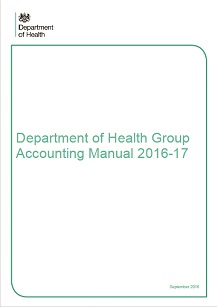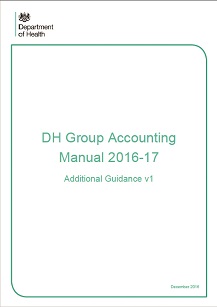Technical / No major accounting changes but attention still needed to detail
The 2016/17 accounting year is a quiet one in terms of changes to accounting standards or government reporting requirements, writes Debbie Paterson. However, the HFMA’s annual pre-accounts briefing sessions at the end of January were well attended as usual. And it is worth a recap of the key issues that will impact on this year’s year-end process and reporting.
The Department of Health’s Group accounting manual (GAM) for 2016/17 has been issued (and updated) and the 2017/18 GAM is out for consultation.

As has been well trailed, the GAM applies to all NHS bodies in respect of their accounts so foundation trusts need to get used to looking in a different place for guidance. However, for the annual report, foundation trusts continue to follow the NHS foundation trust annual reporting manual, while everyone else refers to chapter 2 of the GAM.
Foundation trusts should be aware that
the move to the GAM has resulted in changes for them and the best place to look for the details in relation to those changes is the GAM consultation response. None of these changes are expected to cause any major difficulties for NHS bodies.
The big change for everyone is that the staff costs note has been moved to the remuneration/staff report in the annual report. The accounts can still include the full note or a summary note cross referenced to the remuneration report. The note is still subject to audit and the information will still be collected in summarisation schedules for consolidation.

It is likely that the GAM will be updated again soon to reflect a change made by the Treasury to its Financial reporting manual, which is already reflected in the FT Annual reporting manual. The first column of the single total figure of remuneration table is ‘salary’, which until now has not included any severance or payments for loss of office. From now on this figure should include such payments.
The GAM was updated in December with the issue of eight FAQs – so ensure you are working from the most up-to-date version. FAQ 1 provides the discount rates for post-employment benefits and general provisions.
All the discount rates have decreased, which means that provisions will increase with a resulting impact on expenditure. Bodies reported that the change in the rate relating to post-employment benefits is resulting in a significant impact on their bottom line so revised provisions should be calculated as early as possible.
The Department and NHS Improvement are still working on guidance on accounting for sustainability and transformation funding (STF), so there will be more FAQs as 31 March approaches.
This is likely to be the most complicated issue this year, as providers will have to estimate the amount of income they expect to receive when preparing their draft accounts based on their own assessment of whether they have met the necessary conditions.
Audit adjustments could affect the amount receivable, making accurate estimates for accounts vital. This means following the guidance to the letter. The STF will be part of the agreement of balances exercise and will be agreed with NHS England.
At the end of another difficult financial year, finance professionals should be confident in their own judgements and estimates, but must apply financial rigour. It is vital that forecasts and estimates provided to any of the consolidating bodies are as accurate and up-to-date as possible as they rely on them to determine their financial position.
Auditors are likely to be very interested in going concern assessments and disclosures, which should focus on any uncertainties in relation to funding in the 12 months following the date that the accounts are signed off. NHS Improvement will not be issuing any letters in relation to financial support this year.
Auditors also remain interested in the property valuations, particularly whether they are on an alternative site basis and whether they include or exclude VAT. Any valuation issues should be discussed with auditors as early as possible.
There are no major changes planned for the agreement of balances exercise because last year it went so well. So the message here is to keep up the good work.
Technical review
A ‘more efficient and flexible’ secondary uses service (SUS) will be up and running in April, NHS Digital has confirmed. The new SUS+ system will run in parallel to the existing SUS system until late in June when the legacy system will be decommissioned. NHS providers submit activity data to the data warehousing system, which supports secondary uses of this data to inform planning and commissioning and enable provider reimbursement under the national tariff. NHS Digital, which manages the system, said that SUS+ will feel very similar to the existing system but will process data faster and be more cost effective to operate. The period of dual running from April to the end of June will enable users to complete processing 2016/17 data with consistent data from SUS. SUS+ will support payment by results data for two previous historical years plus the current year. This will involve re-processing 2015/16 and 2016/17 data. Changes in processing such as simplified spell construction mean there may be marginal differences in results obtained by SUS and SUS+.
NHS Digital has also given notification of a new commissioning data set type for emergency care. It said the existing data had not kept pace with the increasing complexity of delivering emergency care and was not adequate to support effective service planning. Emergency departments may start to submit the new data in August, but must start doing so from October 2017 or 2018 depending on the department type.
The HFMA has broadly backed proposals by NHS Improvement and the Care Quality Commission for a new use of resources assessment (see Healthcare Finance, February 2017 page 31). However, in its response to consultation, it has called for terminology to be clarified to prevent confusion between the existing finance and use of resources assessment in the single oversight framework, which will continue to be reported monthly, and the new wider-ranging, annual use of resources assessment. In terms of how the new use of resources assessment could be combined in future with the CQC’s existing quality rating, the HFMA recognises that adding a sixth question to the existing five (safe, effective, caring, responsive and well-led) would ‘require less change and be easy to understand’. However creating an overall rating broken into three elements – with a quality element combining the safe, effective, caring and responsive ratings presented alongside leadership (well-led) and use of resources – would give an increasing focus to resources and leadership. The association backed proposed metrics as a good starting point and suggested other options. It also said in future assessment should move beyond individual organisations to look at whole system performance.
Many NHS organisations have historically commissioned a range of services from external audit suppliers that are not part of the statutory audit. Revised ethical standards from the Financial Reporting Council, effective for accounting periods starting on or after 16 June 2016, will affect the type and quantity of non-audit services that auditors can provide. National Audit Office guidance relating to the new standard, aimed at auditors of NHS organisations – Auditor guidance note 1 – states that the total value of non-audit services provided by the external auditor to an audit client should not exceed 70% of the organisation’s statutory audit fee. This requirement also applies to any associated controlled entities. Certain non-audit work that the external auditor is required to carry out, including assurance work on the quality account, is excluded from the calculation. There are also certain types of non-audit services that are now prohibited, including taxation and valuation services. Foundation trusts already set their own policies for commissioning non-audit services from their external auditors, but will now need to consider the introduction of the cap and limitations on the type of services that can be commissioned. The arrangements for external audit services for NHS trusts and clinical commissioning groups (CCGs) were previously managed by the company Public Sector Audit Appointments. As these organisations now appoint their own external auditor, they will also need to be aware of the new requirements when considering future arrangements for contracting and oversight of non-audit services.
Related content
The Institute’s annual costing conference provides the NHS with the latest developments and guidance in NHS costing.
The value masterclass shares examples of organisations and systems that have pursued a value-driven approach and the results they have achieved.